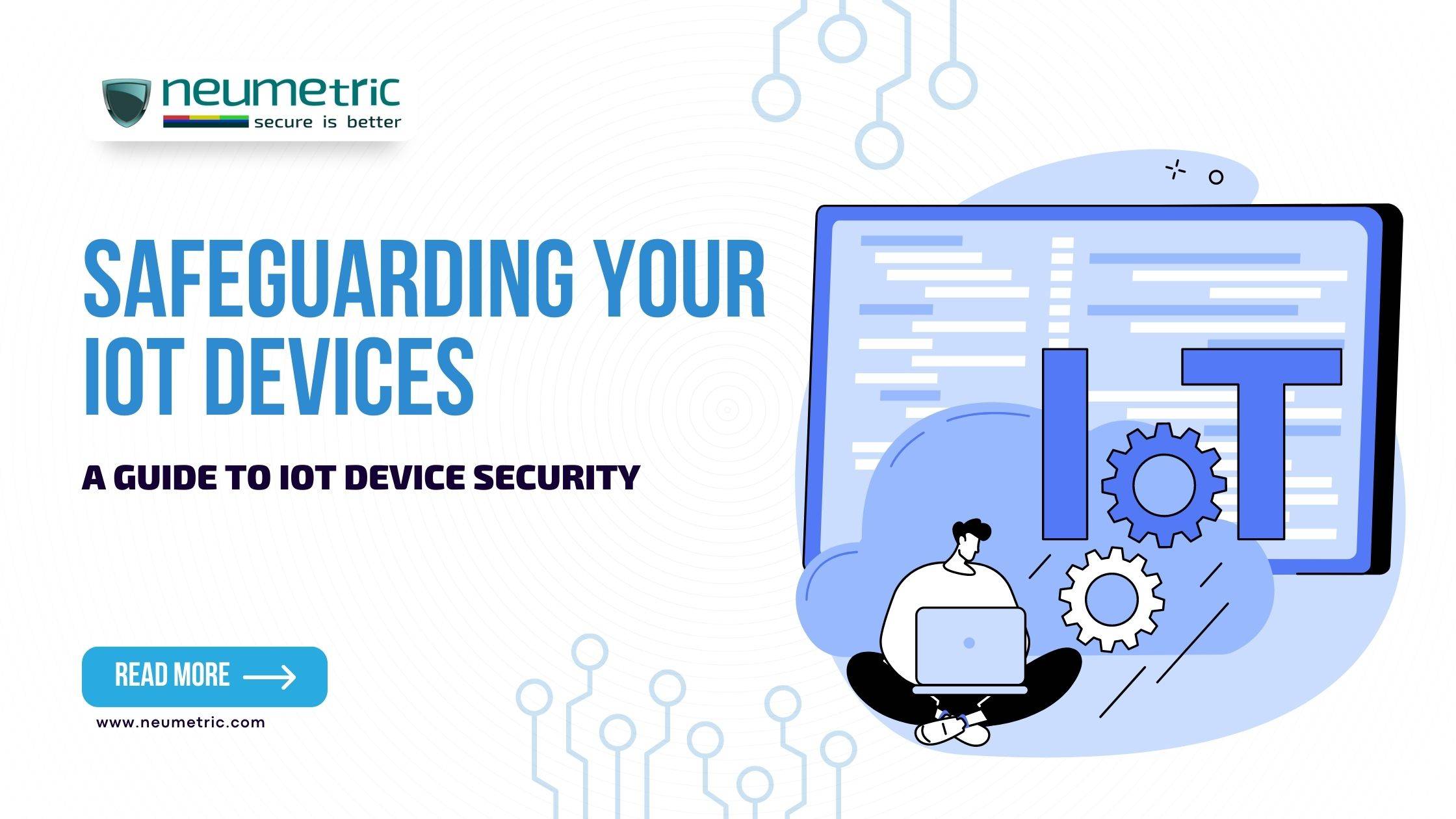Table of Contents
ToggleSafeguarding Your IoT Devices: A Guide to IoT Device Security
Introduction
The growing significance of Internet of Things [IoT] device security stems from the exponential increase in interconnected devices. IoT has become an integral part of various sectors, including healthcare, transportation & manufacturing, enhancing efficiency & convenience. However, this interconnectedness also introduces vulnerabilities that can be exploited by cybercriminals. IoT device security is crucial to safeguard against potential risks such as unauthorised access, data breaches & disruption of critical services.
Securing IoT devices against cyber threats is of utmost importance due to the potential consequences of compromised devices. IoT devices often collect & transmit sensitive data, ranging from personal information to critical infrastructure controls. Breaches in IoT device security can lead to severe repercussions, including privacy violations, financial losses, physical harm & even disruption of essential services. Protecting IoT devices against cyber threats is vital to maintain trust in the technology, safeguard user information & ensure the smooth functioning of interconnected systems.
Understanding IoT Device Security
IoT device security refers to the measures & practices implemented to protect Internet of Things [IoT] devices from unauthorised access, data breaches & malicious activities. It encompasses the protection of both hardware & software components, as well as the communication networks connecting these devices. The scope of IoT device security includes authentication & access control mechanisms, encryption techniques, secure software development practices & robust network infrastructure. It also involves ensuring the privacy & integrity of the data transmitted & stored by IoT devices, as well as protecting against physical tampering or unauthorised modifications.
Common vulnerabilities & risks associated with IoT devices:
- Weak or default passwords: IoT devices often come with default or weak passwords, making them easy targets for brute-force attacks.
- Lack of firmware updates: Manufacturers may not provide regular security updates, leaving devices vulnerable to known exploits.
- Inadequate authentication: Insufficient authentication mechanisms can lead to unauthorised access & impersonation attacks.
- Lack of encryption: Unencrypted data transmission exposes sensitive information to interception & tampering.
- Insecure network connections: Weak or unsecured Wi-Fi networks can be exploited to gain access to IoT devices.
- Physical tampering: Physical access to IoT devices can result in unauthorised manipulation or theft of data.
- Lack of device management: Poor device management practices can lead to unpatched vulnerabilities & unauthorised device access.
- Privacy concerns: IoT devices may collect & transmit personal data without adequate privacy safeguards, risking user privacy.
- Supply chain attacks: Compromised components or malicious software introduced during the manufacturing process can compromise device security.
- Lack of user awareness: Users may not be aware of the risks associated with IoT devices or fail to implement proper security measures, making them susceptible to attacks.
Best Practices for IoT Device Security
- Strong Passwords & Authentication: It is crucial to use strong & unique passwords for all IoT devices to prevent unauthorised access. Implementing multi-factor authentication adds an extra layer of security.
- Regular Firmware Updates & Patching: Regularly updating firmware is vital to address vulnerabilities & protect against emerging threats. Timely application of security patches & fixes is equally important.
- Network Segmentation & Isolation: Network segmentation & isolation help prevent unauthorised access by separating IoT devices from critical network infrastructure. Isolating IoT devices also minimises potential attack surfaces.
- Data Encryption & Privacy: Data encryption, both in transit & at rest, ensures the confidentiality & integrity of sensitive information. Protecting user privacy is equally paramount & measures should be taken to safeguard user data & sensitive information.
Securing IoT Communication
- Secure Protocols & Encryption: Utilising secure protocols such as HTTPS & TLS/SSL adds a layer of protection to IoT data transmission. Also, implementing end-to-end encryption ensures that data remains secure throughout the communication process.
- Secure Authentication & Authorization: To enhance security further, secure authentication mechanisms must be established to verify IoT device communication, preventing unauthorised access. Lastly, granular authorization controls should be put in place, allowing only authorised devices or users to access specific IoT resources.
By incorporating these measures, IoT systems can mitigate security risks & protect sensitive information from unauthorised access.
Physical Security Considerations
- Securing Physical Access to IoT Devices:
- Restricting physical access to unauthorised personnel: Restricting physical access to unauthorised personnel is crucial to IoT device security. By implementing strict access controls, such as keycard systems or biometric authentication, only authorised individuals can interact with the devices.
- Implementing tamper-proof mechanisms & sensors: Implementing tamper-proof mechanisms & sensors adds an extra layer of security. These mechanisms can detect any attempts to physically manipulate or tamper with the devices, triggering alerts or rendering the device inoperable to protect against unauthorised access.
- Supply Chain Security:
- Verifying device integrity throughout the supply chain: Verifying device integrity throughout the supply chain is essential. Employing robust authentication mechanisms & cryptographic techniques ensures that the devices remain unaltered & authentic during transportation & storage.
- Addressing potential security risks during manufacturing & distribution: Addressing potential security risks during manufacturing & distribution involves implementing rigorous security protocols. Conducting thorough background checks on suppliers, monitoring production processes & securely storing & shipping devices can mitigate the risk of introducing vulnerabilities into the IoT devices during these stages.
Monitoring & Detection
- Implementing Intrusion Detection Systems [IDS]: Proper implementation of IDS requires careful consideration of network architecture, system configurations & the selection of appropriate detection mechanisms to effectively safeguard against various types of cyber threats.
- Network Traffic Monitoring & Anomaly Detection: Effective network traffic monitoring & anomaly detection provide valuable insights into potential threats, allowing organisations to respond promptly & prevent further compromise.
- Real-time Alerts & Incident Response: Timely & effective incident response is crucial to minimise the potential damage & ensure the security of the network & systems.
Compliance & Standards
IoT security standards & frameworks are crucial for ensuring the protection of interconnected devices. Various organisations & industry bodies have developed standards to address the unique security challenges posed by the IoT. Examples include the Industrial Internet Consortium [IIC] Security Framework, the National Institute of Standards & Technology [NIST] Cybersecurity Framework & the Open Web Application Security Project [OWASP] IoT Top 10. These frameworks provide guidelines & best practices for securing IoT devices, networks & data, covering aspects such as authentication, encryption, access control & vulnerability management.
Compliance with IoT device security standards is essential to minimise vulnerabilities & safeguard sensitive data. Organisations must ensure that their IoT devices adhere to relevant security regulations & standards, such as the General Data Protection Regulation [GDPR] & the California Consumer Privacy Act [CCPA]. Compliance considerations include conducting thorough risk assessments, implementing strong authentication mechanisms, encrypting data at rest & in transit, regularly updating firmware & establishing robust monitoring & incident response protocols. Compliance with these measures helps to enhance the overall security posture of IoT ecosystems & protect against potential threats.
User Education & Awareness
By raising awareness, users can better understand the potential vulnerabilities associated with IoT devices & take necessary precautions. Emphasising best practices like using strong & unique passwords, regularly updating firmware & disabling unnecessary features can significantly enhance device security. Through user education, individuals can become more vigilant, proactive & knowledgeable in safeguarding their IoT devices & protecting their personal information from potential threats.
Promoting responsible usage & security hygiene is vital to ensure the safety & integrity of IoT devices. Users should be encouraged to adopt good security practices from the start, such as purchasing devices from reputable manufacturers, verifying the authenticity of software updates & keeping devices physically secure. Additionally, promoting the use of network segmentation & firewalls to isolate IoT devices from critical systems can enhance security. By fostering a culture of responsible usage & security hygiene, users can actively contribute to the overall resilience of IoT ecosystems & minimise the risk of cyber threats.
Conclusion
Implementing effective security practices for IoT devices is crucial to safeguarding sensitive data & ensuring the privacy of users. Regularly updating firmware, using strong authentication methods & monitoring network traffic are key practices for protecting against potential threats. It is imperative to emphasise the significance of proactive security measures when it comes to IoT devices. By staying vigilant, conducting regular vulnerability assessments & promptly addressing any vulnerabilities, users can minimise the risk of cyber attacks & maintain the integrity of their connected devices.
To secure the rapidly expanding IoT landscape, it is essential to encourage the widespread adoption of robust security strategies. This includes implementing end-to-end encryption, establishing strong access controls & promoting continuous monitoring & patching of IoT devices. By prioritising security, we can create a safer & more reliable IoT ecosystem for all stakeholders.
FAQs:
How can I protect my IoT devices from vulnerabilities?
To protect your IoT devices from vulnerabilities, ensure they are running the latest firmware & software updates. Implement strong passwords & two-factor authentication [2FA]. Separate your IoT devices on a dedicated network, use firewalls & regularly monitor network traffic for any suspicious activity.
What are security vulnerabilities in IoT devices?
Security vulnerabilities in IoT devices can include weak authentication mechanisms, outdated firmware or software, insecure communication protocols, lack of encryption & default or easily guessable passwords. Additionally, insufficient data protection, unpatched vulnerabilities & insecure physical access to the devices can also pose significant risks. Regular security audits & assessments can help identify & mitigate these vulnerabilities.





